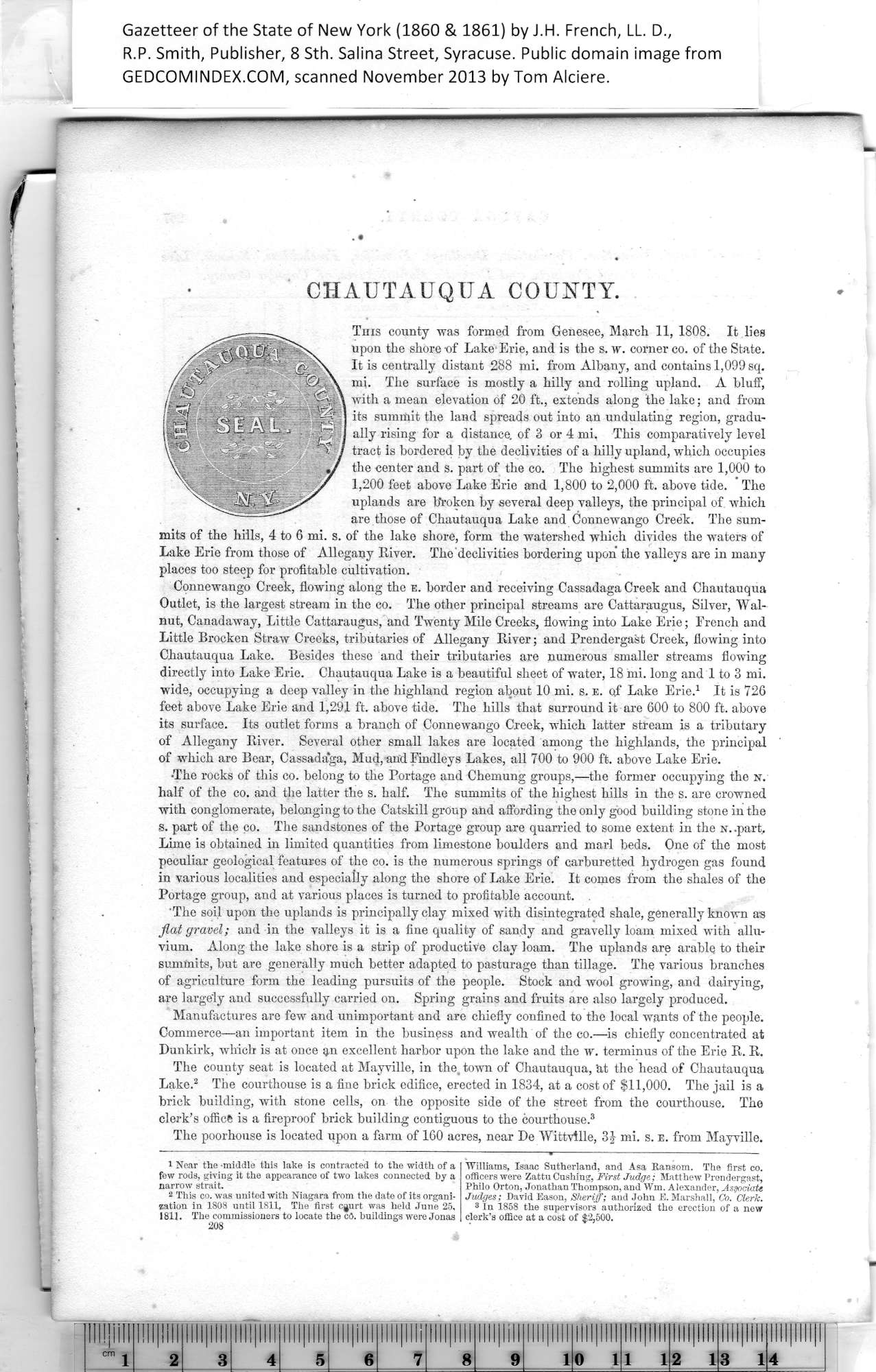|
CHAUTAUQUA COUNTY.
This county was formed from Genesee, March 11, 1808. It lies
upon the shore -of Lake* Erie, and is the s. w. corner co. of the State.
It is centrally distant 288 mi. from Albany, and contains 1,099 sq.
mi. The surface is mostly a hilly and rolling upland. A bluff,
with a mean elevation of 20 ft., extends along the lake; and from
its summit the land spreads out into an undulating region, gradu¬
ally rising for a distance, of 3 or 4 mi. This comparatively level
tract is bordered by the declivities of a hilly upland, which occupies
the center and s. part of the co. The highest summits are 1,000 to
1,200 feet above Lake Erie and 1,800 to 2,000 ft. above tide. The
uplands are broken by several deep valleys, the principal of which
are those of Chautauqua Lake and Connewango Creek. The sum¬
mits of the hills, 4 to 6 mi. s. of the lake shore, form the watershed which divides the waters of
Lake Erie from those of Allegany River. The declivities bordering upon the valleys are in many
places too steep for profitable cultivation.
Connewango Creek, flowing along the e. border and receiving Cassadaga Creek and Chautauqua
Outlet, is the largest stream in the co. The other principal streams are Cattaraugus, Silver, Wal¬
nut, Canadaway, Little Cattaraugus, and Twenty Mile Creeks, flowing into Lake Erie; French and
Little Brocken Straw Creeks, tributaries of Allegany River; and Prenderga'st Creek, flowing into
Chautauqua Lake. Besides these and their tributaries are numerous smaller streams flowing
directly into Lake Erie. Chautauqua Lake is a beautiful sheet of water, 18 mi. long and 1 to 3 mi.
wide, occupying a deep valley in the highland region about 10 mi. s. E. of Lake Erie.1 It is 726
feet above Lake Erie and 1,291 ft. above tide. The hills that surround it are 600 to 800 ft. above
its surface. Its outlet forms a branch of Connewango Creek, which latter stream is a tributary
of Allegany River. Several other small lakes are located among the highlands, the principal
of which are Bear, Cassadaga, Mud, and Findleys Lakes, all 700 to 900 ft. above Lake Erie.
•The rocks of this co. belong to the Portage and Chemung groups,—the former occupying the n.
half of the co. and the latter the s. half. The summits of the highest hills in the s. are crowned
with conglomerate, belonging to the Catskiil group and affording the only good building stone in the
s. part of the co. The sandstones of the Portage group are quarried to some extent in the n. .part.
Lime is obtained in limited quantities from limestone boulders and marl beds. One of the most
peculiar geological features of the co. is the numerous springs of carburetted hydrogen gas found
in various localities and especially along the shore of Lake Erie. It comes from the shales of the
Portage group, and at various places is turned to profitable account.
The soil upon the uplands is principally clay mixed with disintegrated shale, generally known as
flat gravel; and in the valleys it is a fine quality of sandy and gravelly loam mixed with allu¬
vium. Along the lake shore is a strip of productive clay loam. The uplands are arable to their
summits, but are generally much better adapted to pasturage than tillage. The various branches
of agriculture form the leading pursuits of the people. Stock and wool growing, and dairying,
are largely and successfully carried on. Spring grains and fruits are also largely produced.
Manufactures are few and unimportant and are chiefly confined to the local wants of the people.
Commerce—an important item in the business and wealth of the co.—is chiefly concentrated at
Dunkirk, which is at once gn excellent harbor upon the lake and the w. terminus of the Erie R. R.
The county seat is located at Mayville, in the, town of Chautauqua, "at the head of Chautauqua
Lake.2 The courthouse is a fine brick edifice, erected in 1834, at a cost of $11,000. The jail is a
brick building, with stone cells, on the opposite side of the street from the courthouse. The
clerk’s office is a fireproof brick building contiguous to the courthouse.2
The poorhouse is located upon a farm of 160 acres, near De Wittville, 3} mi. s. e. from Mayville.
|
Williams, Isaac Sutherland, and Asa Ransom. The first co.
officers were Zattu Cushing, First Judge; Matthew Prendergast,
Philo Orton, Jonathan Thompson, and Wm. Alexander, Associate
Judges; David Eason, Sheriff; and John E. Marshall, Co. Clerk.
8 In 1858 the supervisors authorized the erection of a new
clerk’s office at a cost of $2,500. |
1
Near the -middle this lake is contracted to the width of a
few rods, giving it the appearance of two lakes connected by a
narrow strait.
2
1811. The commissioners to locate the cd. buildings were Jonas
|
